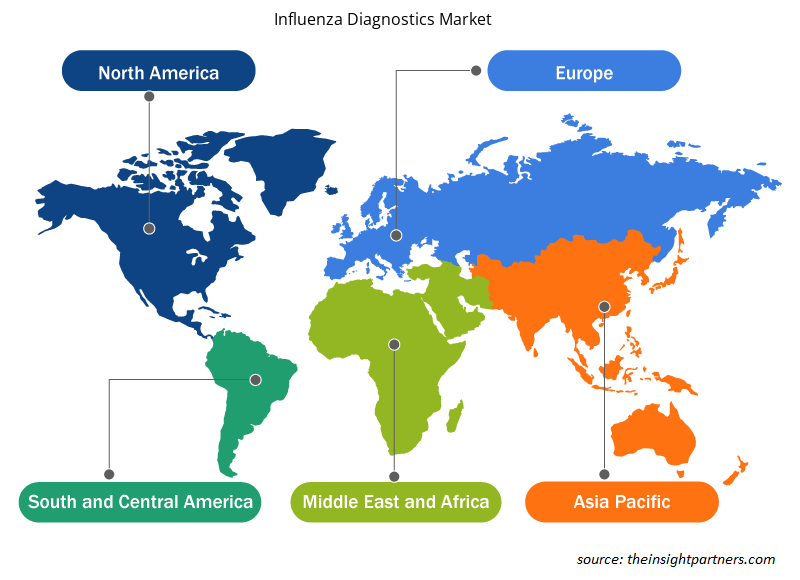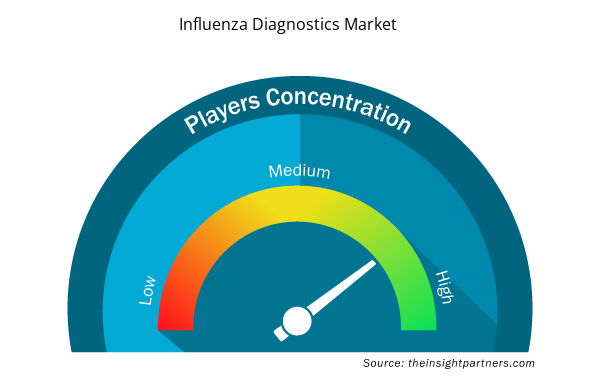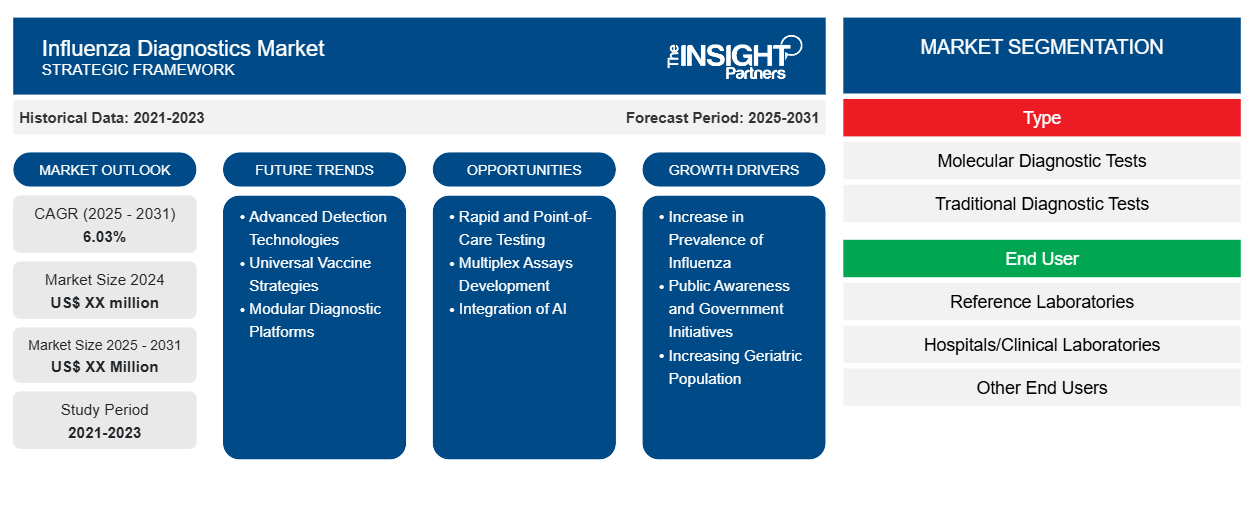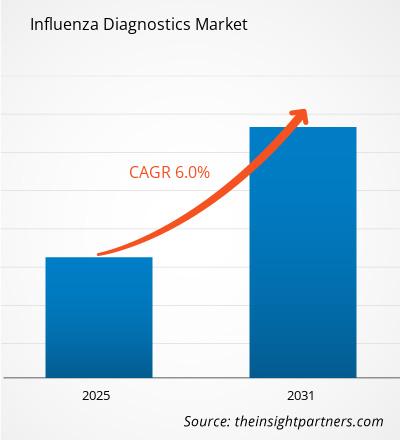Se espera que el mercado de diagnóstico de influenza registre una CAGR del 6,03 % entre 2023 y 2031, con un tamaño de mercado que se expandirá de US$ XX millones en 2023 a US$ XX millones en 2031.
El informe está segmentado por tipo (pruebas de diagnóstico molecular, pruebas de diagnóstico tradicionales); usuario final (laboratorios de referencia, hospitales/laboratorios clínicos, otros usuarios finales). El análisis global se desglosa aún más a nivel regional y por países principales. El informe ofrece el valor en USD para el análisis y los segmentos anteriores.
Propósito del Informe
El informe Influenza Diagnostics Market de The Insight Partners tiene como objetivo describir el panorama actual y el crecimiento futuro, los principales factores impulsores, los desafíos y las oportunidades. Esto proporcionará información a diversas partes interesadas del negocio, como:
- Proveedores/fabricantes de tecnología: Para comprender la dinámica cambiante del mercado y conocer las oportunidades potenciales de crecimiento, lo que les permitirá tomar decisiones estratégicas informadas.
- Inversionistas: Realizar un análisis exhaustivo de tendencias sobre la tasa de crecimiento del mercado, las proyecciones financieras del mercado y las oportunidades que existen en toda la cadena de valor.
- Órganos reguladores: Regular las políticas y vigilar las actividades del mercado con el objetivo de minimizar los abusos, preservar la confianza de los inversores y defender la integridad y estabilidad del mercado.
Segmentación del mercado de diagnóstico de la influenza
Tipo
- Pruebas de diagnóstico molecular
- Pruebas de diagnóstico tradicionales
Usuario final
- Laboratorios de referencia
- Hospitales/Laboratorios Clínicos
- Otros usuarios finales
Personalice este informe según sus necesidades
Obtendrá personalización en cualquier informe, sin cargo, incluidas partes de este informe o análisis a nivel de país, paquete de datos de Excel, así como también grandes ofertas y descuentos para empresas emergentes y universidades.
- Obtenga las principales tendencias clave del mercado de este informe.Esta muestra GRATUITA incluirá análisis de datos, desde tendencias del mercado hasta estimaciones y pronósticos.
Factores impulsores del crecimiento del mercado de diagnóstico de la gripe
- Aumento de la prevalencia de la gripe: en 2021, los Centros para el Control y la Prevención de Enfermedades (CDC) afirmaron que 9 millones de pacientes se vieron afectados por la gripe. Según las actualizaciones de febrero de 2021 de la Organización Mundial de la Salud (OMS), los laboratorios del SMVRG de la OMS analizaron más de 490 516 muestras en 2021-2022. El aumento de los casos de gripe entre la población mundial está impulsando la demanda de herramientas de diagnóstico de la gripe para la detección y prevención de la enfermedad.
- Concienciación pública e iniciativas gubernamentales: una mayor concienciación sobre la gripe a través de campañas sanitarias patrocinadas por el gobierno aumentará la importancia de la detección temprana, lo que hará que más pacientes busquen tratamiento, lo que a su vez fomentará la demanda de diagnósticos de gripe.
- Aumento de la población geriátrica: el enorme crecimiento de la población de edad avanzada actúa como un combustible para el mercado de diagnóstico de la gripe. Los adultos mayores son propensos a sufrir complicaciones a causa de la gripe y, por lo tanto, se experimenta una mayor demanda de pruebas de diagnóstico para el tratamiento de su estado de salud.
Tendencias futuras del mercado de diagnóstico de la gripe
- Tecnologías de detección avanzadas: Los futuros diagnósticos de influenza desarrollados con estrategias de detección más sofisticadas, incluyendo secuenciación de próxima generación y tecnologías genómicas, harán posible una mayor sensibilidad y especificidad, lo que permitirá la identificación más rápida de los virus de influenza específicos involucrados, siendo por lo tanto mucho más de gran ayuda para diseñar tratamientos adecuados para las enfermedades y controlar los brotes.
- Estrategias de vacunación universal: Aunque la construcción de vacunas panvirales estará orientada principalmente al desarrollo de vacunas, las nuevas tecnologías pueden tener un impacto en el diagnóstico. Estas vacunas son más eficaces para atacar los componentes conservados de los virus y, por lo tanto, pueden contribuir a una mejor identificación de las cepas de gripe que se utilizarían para modificar las pruebas de diagnóstico.
- Plataformas de diagnóstico modulares: Las futuras plataformas de diagnóstico deberán desarrollarse con la capacidad de adaptarse rápidamente a las cepas de la gripe u otros virus respiratorios, etc. La adaptabilidad debería ayudar a responder con una rapidez sin precedentes a las actualizaciones del sistema de atención sanitaria ante las amenazas emergentes.
Oportunidades de mercado para el diagnóstico de la gripe
- Pruebas rápidas y en el punto de atención: el desarrollo de pruebas de diagnóstico rápido que se puedan utilizar en el punto de atención brindaría oportunidades de crecimiento lucrativas en el mercado de diagnóstico de la gripe. Estas pruebas ayudarán a los proveedores de atención médica a diagnosticar la gripe más rápidamente en clínicas, salas de emergencia y otros entornos, lo que permitirá un tratamiento rápido y minimizar la propagación del virus.
- Desarrollo de ensayos multiplex: los diagnósticos futuros pueden incluir ensayos multiplex que puedan detectar simultáneamente múltiples patógenos respiratorios, entre ellos varios subtipos de influenza. Esto agilizará los procesos de prueba y mejorará la eficiencia general de los diagnósticos en casos de enfermedades respiratorias, creando oportunidades para los actores del mercado.
- Integración de la IA: El papel de la IA y el aprendizaje automático en el diagnóstico de la gripe va a ser de gran ayuda para proporcionar resultados más precisos y más rápidos. Las tecnologías en este sentido tienen la capacidad de escanear grandes conjuntos de datos para identificar los patrones predominantes y predecir brotes, fortaleciendo así las respuestas contra la amenaza de la gripe.
Perspectivas regionales del mercado de diagnóstico de la gripe
Los analistas de Insight Partners explicaron en detalle las tendencias y los factores regionales que influyen en el mercado de diagnóstico de la gripe durante el período de pronóstico. Esta sección también analiza los segmentos y la geografía del mercado de diagnóstico de la gripe en América del Norte, Europa, Asia Pacífico, Oriente Medio y África, y América del Sur y Central.

- Obtenga datos regionales específicos para el mercado de diagnóstico de influenza
Alcance del informe de mercado sobre diagnóstico de la influenza
| Atributo del informe | Detalles |
|---|---|
| Tamaño del mercado en 2023 | XX millones de dólares estadounidenses |
| Tamaño del mercado en 2031 | US$ XX millones |
| CAGR global (2023 - 2031) | 6,03% |
| Datos históricos | 2021-2022 |
| Período de pronóstico | 2024-2031 |
| Segmentos cubiertos | Por tipo
|
| Regiones y países cubiertos | América del norte
|
| Líderes del mercado y perfiles de empresas clave |
|
Densidad de actores del mercado de diagnóstico de influenza: comprensión de su impacto en la dinámica empresarial
El mercado de diagnóstico de la gripe está creciendo rápidamente, impulsado por la creciente demanda de los usuarios finales debido a factores como la evolución de las preferencias de los consumidores, los avances tecnológicos y una mayor conciencia de los beneficios del producto. A medida que aumenta la demanda, las empresas amplían sus ofertas, innovan para satisfacer las necesidades de los consumidores y aprovechan las tendencias emergentes, lo que impulsa aún más el crecimiento del mercado.
La densidad de actores del mercado se refiere a la distribución de las empresas o firmas que operan dentro de un mercado o industria en particular. Indica cuántos competidores (actores del mercado) están presentes en un espacio de mercado determinado en relación con su tamaño o valor total de mercado.
Las principales empresas que operan en el mercado de diagnóstico de influenza son:
- Abad
- Corporación Quidel
- BioMérieux
- BD
- F. Hoffmann-La Roche Ltd
Descargo de responsabilidad : Las empresas enumeradas anteriormente no están clasificadas en ningún orden particular.

- Obtenga una descripción general de los principales actores clave del mercado de diagnóstico de influenza
Puntos de venta clave
- Cobertura integral: el informe cubre de manera integral el análisis de productos, servicios, tipos y usuarios finales del mercado de diagnóstico de influenza, proporcionando un panorama holístico.
- Análisis de expertos: el informe se compila sobre la base de un profundo conocimiento de expertos y analistas de la industria.
- Información actualizada: El informe asegura relevancia comercial debido a su cobertura de información reciente y tendencias de datos.
- Opciones de personalización: este informe se puede personalizar para satisfacer los requisitos específicos del cliente y adaptarse adecuadamente a las estrategias comerciales.
Por lo tanto, el informe de investigación sobre el mercado de diagnóstico de la influenza puede ayudar a abrir camino para descifrar y comprender el escenario de la industria y las perspectivas de crecimiento. Si bien puede haber algunas preocupaciones válidas, los beneficios generales de este informe tienden a superar las desventajas.
- Análisis histórico (2 años), año base, pronóstico (7 años) con CAGR
- Análisis PEST y FODA
- Tamaño del mercado Valor/volumen: global, regional, nacional
- Industria y panorama competitivo
- Conjunto de datos de Excel



Report Coverage
Revenue forecast, Company Analysis, Industry landscape, Growth factors, and Trends

Segment Covered
This text is related
to segments covered.

Regional Scope
North America, Europe, Asia Pacific, Middle East & Africa, South & Central America

Country Scope
This text is related
to country scope.
Preguntas frecuentes
The Influenza Diagnostics Market is estimated to witness a CAGR of 6.03% from 2023 to 2031
The major factors driving the influenza diagnostics market are:
1. Increase in Prevalence of Atrial fibrillation (AF)
2.Rising Awareness and Screening
3.Increasing Adoption Rate of Advanced Technologies
North America region dominated the influenza diagnostics market in 2023
Asia Pacific region dominated the influenza diagnostics market in 2023
The molecular diagnostic tests segment accounts for a higher revenue in product segment of the influenza diagnostics market in 2023.
Abbott, Quidel Corporation, BioMérieux, BD, F. Hoffmann-La Roche Ltd, Oxford Biosystems, Thermo Fisher Scientific, Meridian Bioscience, and Cepheid. are some of the major players operating in the influenza diagnostics market.
Trends and growth analysis reports related to Life Sciences : READ MORE..
The List of Companies
1. Abbott
2. Quidel Corporation
3. BioMérieux
4. BD
5. F. Hoffmann-La Roche Ltd
6. Oxford Biosystems
7. Thermo Fisher Scientific
8. Meridian Bioscience
9. Cepheid
10. altona Diagnostics GmbH
The Insight Partners performs research in 4 major stages: Data Collection & Secondary Research, Primary Research, Data Analysis and Data Triangulation & Final Review.
- Data Collection and Secondary Research:
As a market research and consulting firm operating from a decade, we have published and advised several client across the globe. First step for any study will start with an assessment of currently available data and insights from existing reports. Further, historical and current market information is collected from Investor Presentations, Annual Reports, SEC Filings, etc., and other information related to company’s performance and market positioning are gathered from Paid Databases (Factiva, Hoovers, and Reuters) and various other publications available in public domain.
Several associations trade associates, technical forums, institutes, societies and organization are accessed to gain technical as well as market related insights through their publications such as research papers, blogs and press releases related to the studies are referred to get cues about the market. Further, white papers, journals, magazines, and other news articles published in last 3 years are scrutinized and analyzed to understand the current market trends.
- Primary Research:
The primarily interview analysis comprise of data obtained from industry participants interview and answers to survey questions gathered by in-house primary team.
For primary research, interviews are conducted with industry experts/CEOs/Marketing Managers/VPs/Subject Matter Experts from both demand and supply side to get a 360-degree view of the market. The primary team conducts several interviews based on the complexity of the markets to understand the various market trends and dynamics which makes research more credible and precise.
A typical research interview fulfils the following functions:
- Provides first-hand information on the market size, market trends, growth trends, competitive landscape, and outlook
- Validates and strengthens in-house secondary research findings
- Develops the analysis team’s expertise and market understanding
Primary research involves email interactions and telephone interviews for each market, category, segment, and sub-segment across geographies. The participants who typically take part in such a process include, but are not limited to:
- Industry participants: VPs, business development managers, market intelligence managers and national sales managers
- Outside experts: Valuation experts, research analysts and key opinion leaders specializing in the electronics and semiconductor industry.
Below is the breakup of our primary respondents by company, designation, and region:

Once we receive the confirmation from primary research sources or primary respondents, we finalize the base year market estimation and forecast the data as per the macroeconomic and microeconomic factors assessed during data collection.
- Data Analysis:
Once data is validated through both secondary as well as primary respondents, we finalize the market estimations by hypothesis formulation and factor analysis at regional and country level.
- Macro-Economic Factor Analysis:
We analyse macroeconomic indicators such the gross domestic product (GDP), increase in the demand for goods and services across industries, technological advancement, regional economic growth, governmental policies, the influence of COVID-19, PEST analysis, and other aspects. This analysis aids in setting benchmarks for various nations/regions and approximating market splits. Additionally, the general trend of the aforementioned components aid in determining the market's development possibilities.
- Country Level Data:
Various factors that are especially aligned to the country are taken into account to determine the market size for a certain area and country, including the presence of vendors, such as headquarters and offices, the country's GDP, demand patterns, and industry growth. To comprehend the market dynamics for the nation, a number of growth variables, inhibitors, application areas, and current market trends are researched. The aforementioned elements aid in determining the country's overall market's growth potential.
- Company Profile:
The “Table of Contents” is formulated by listing and analyzing more than 25 - 30 companies operating in the market ecosystem across geographies. However, we profile only 10 companies as a standard practice in our syndicate reports. These 10 companies comprise leading, emerging, and regional players. Nonetheless, our analysis is not restricted to the 10 listed companies, we also analyze other companies present in the market to develop a holistic view and understand the prevailing trends. The “Company Profiles” section in the report covers key facts, business description, products & services, financial information, SWOT analysis, and key developments. The financial information presented is extracted from the annual reports and official documents of the publicly listed companies. Upon collecting the information for the sections of respective companies, we verify them via various primary sources and then compile the data in respective company profiles. The company level information helps us in deriving the base number as well as in forecasting the market size.
- Developing Base Number:
Aggregation of sales statistics (2020-2022) and macro-economic factor, and other secondary and primary research insights are utilized to arrive at base number and related market shares for 2022. The data gaps are identified in this step and relevant market data is analyzed, collected from paid primary interviews or databases. On finalizing the base year market size, forecasts are developed on the basis of macro-economic, industry and market growth factors and company level analysis.
- Data Triangulation and Final Review:
The market findings and base year market size calculations are validated from supply as well as demand side. Demand side validations are based on macro-economic factor analysis and benchmarks for respective regions and countries. In case of supply side validations, revenues of major companies are estimated (in case not available) based on industry benchmark, approximate number of employees, product portfolio, and primary interviews revenues are gathered. Further revenue from target product/service segment is assessed to avoid overshooting of market statistics. In case of heavy deviations between supply and demand side values, all thes steps are repeated to achieve synchronization.
We follow an iterative model, wherein we share our research findings with Subject Matter Experts (SME’s) and Key Opinion Leaders (KOLs) until consensus view of the market is not formulated – this model negates any drastic deviation in the opinions of experts. Only validated and universally acceptable research findings are quoted in our reports.
We have important check points that we use to validate our research findings – which we call – data triangulation, where we validate the information, we generate from secondary sources with primary interviews and then we re-validate with our internal data bases and Subject matter experts. This comprehensive model enables us to deliver high quality, reliable data in shortest possible time.


 Obtenga una muestra gratuita de este informe
Obtenga una muestra gratuita de este informe